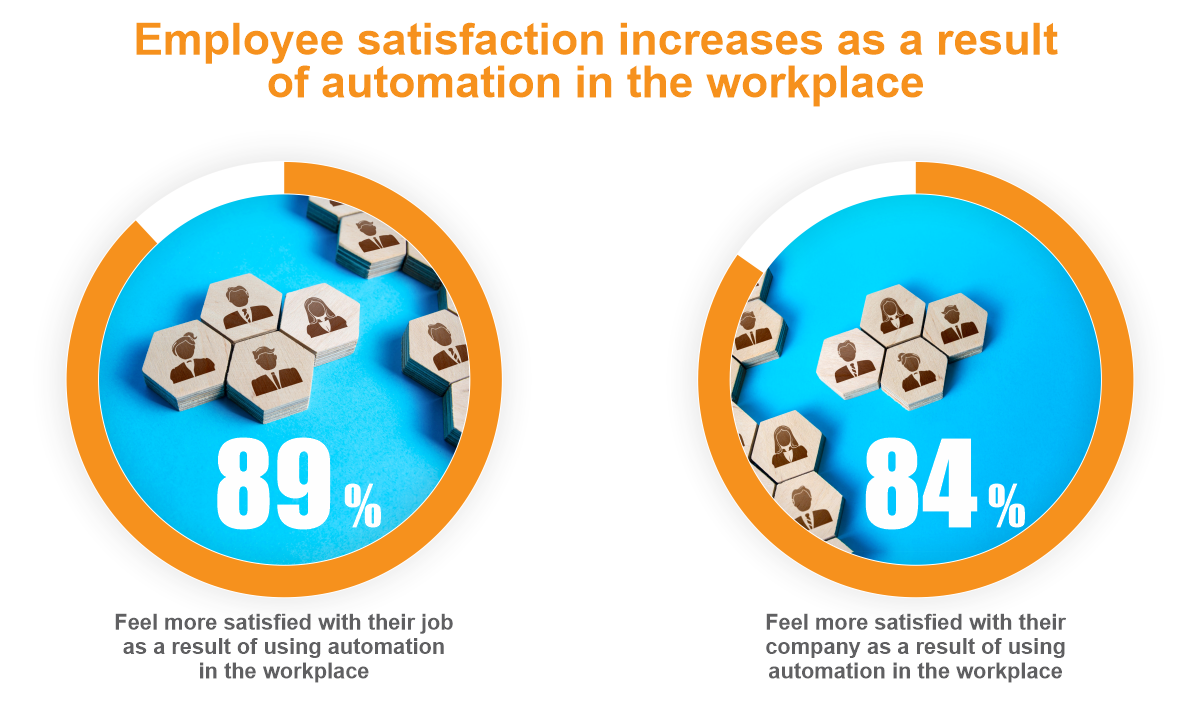Over the last two years, remote and flexible work arrangements have led to more job opportunity than ever before in the workforce. The resulting churn in the job market as employees evaluate their careers and pursue new opportunities has been commonly referred to as "The Great Resignation." The most recent data from the U.S. Bureau of Labor Statistics shows the number of needed workers continues to be greater than the number of workers available, and while the number of job openings has declined slightly over the last two months, there are 1.9 jobs per available worker (Mutikani, 2022).
The ongoing labor shortage, coupled with an increased use of services driven by technology over the last two years, has forced businesses that weren’t considering automation to take a closer look – and those who were already automating to delve deeper and see what’s next.
Hyperautomation: Digital Transformation in Overdrive
For many, the word “automation” implies that employees can be replaced with technology. But in today’s climate, automation must go beyond that to differentiate functions that require human interaction from those that don’t to offset hiring demands. A more recent approach to this is called "hyperautomation," defined as a "disciplined, business-driven approach to rapidly identify, vet and automate as many business and IT processes as possible. Hyperautomation enables scalability, remote operation and business model disruption” (Gartner Information Technology Insights, n.d.). Hyperautomation uses a combination of technologies to digitally transform work processes founded on individual or tribal knowledge into repeatable workflows. Businesses in professional industries can reduce or eliminate manual, repetitive tasks by critically examining day-to-day processes for opportunities to automate.
The concept of hyperautomation has been compared to the Industrial Revolution, when inventions like the cotton gin and steam engine changed the world by accelerating the manufacture and transport of goods. However, an important distinction must be made: while the Industrial Revolution occurred over a significant period, digital transformation can occur much faster. As technology continues to advance rapidly, businesses need to prepare for the future accordingly (Brown, 2022). A survey of executive business leaders earlier this year found that an overwhelming number of executives believe automation is the key to the future – and that those who can transform rapidly have the best chance of success (Intelligent Automation Benchmark Study, 2022).

Automation Is a "Win-Win" for Employers – and Employees
While repetitive tasks can be automated, there will always be responsibilities that require human oversight and intervention. As the labor shortage lingers, employers should leverage automation to improve the employee experience (EX). When undesirable tasks are reduced or eliminated by a digital “worker,” employees are liberated to use their skillsets on value-added tasks or be deployed to new work that challenges and motivates. A better EX will also improve employee engagement as more time is spent on meaningful work. The benefits to employers include increased retention of top talent, lower employee fatigue, higher efficiency and a lower cost of doing business (Ahmed, 2022). Currently, the greatest benefit of automation may be that by maximizing productivity and satisfaction for existing employees, businesses can avoid or reduce the need to acquire more workers, addressing the effects of the Great Resignation from both sides.
Although a mindset shift may be required as employees encounter automation, surveys show that employee satisfaction increases as mundane work is digitized. One survey found that almost 90% of employees were more satisfied with their jobs after automation occurred. Additionally, 88% of those surveyed trusted the automated solutions to complete tasks faster and without error and 86% found that automated solutions helped them make decisions quicker. The time saved allowed employees to invest more heavily in their career and professional relationships. The benefits aren’t solely work related; automation users reported lower stress levels after the monotonous aspects of their work were eliminated through automation (News: SalesForce, 2021).

Digital transformation can’t occur overnight – and as with any change, there are challenges that must be overcome in order to be successful. Choosing the right partner to help navigate those challenges may be the most important aspect of the transformation.
At Vee Healthtek, we know that even if your business is ripe for automation, the prospect can be overwhelming – or you may not even know if it’s possible. That’s where we come in: we’ll partner with you to identify processes that can be automated and implement technology solutions that will streamline workflows, reducing distractions for your talent and focusing them on where they can serve your company best. Schedule time with one of our experts today to see how our team can deliver an outcome that will position you for long-term success – we believe you’ll find us extraordinary.
References:
Ahmed, Z. (2022, April 19). Artificial Intelligence: BuiltIn. Retrieved from BuiltIn: https://builtin.com/artificial-intelligence/automation-employee-retention
Brown, J. (2022, January 14). Bleeding Edge: Brownstone Research. Retrieved from Brownstone Research: https://www.brownstoneresearch.com/bleeding-edge/automation-is-the-solution-to-the-great-resignation/
Groombridge, D. (n.d.). Gartner Information Technology Insights. Retrieved from Gartner: https://www.gartner.com/en/information-technology/insights/top-technology-trends
Intelligent Automation Benchmark Study. (2022). Retrieved from Kofax: https://www.kofax.com/-/media/files/reports/en/kofax-2022-intelligent-automation-benchmark-study.pdf
Mutikani, L. (2022, July 6). U.S. Markets Reuters. Retrieved from Reuters: https://www.reuters.com/markets/us/us-job-openings-stay-high-may-keeping-labor-market-tight-2022-07-06/
News: SalesForce. (2021, December 2). Retrieved from SalesForce: https://www.salesforce.com/news/stories/new-salesforce-research-links-lower-stress-levels-and-business-automation/
